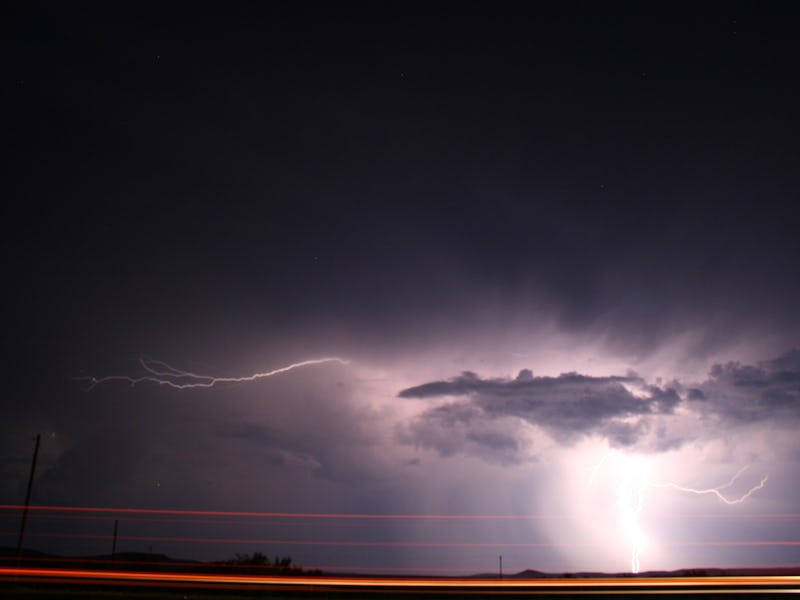The strangest part of a thunderstorm may have finally been explained
Previously thought to be unrelated, two natural phenomena are both spurred by lightning.

Thunderstorms can excite and inspire us, putting on a show. The flashes and crackles we see from Earth light up the sky and send your dog into hiding.But what’s going on high above the clouds during a storm may be even more intriguing.
Strange phenomena light up the place where, roughly speaking, the atmosphere ends and space begins. There, terrestrial gamma-ray flashes, short bursts of incredibly high-energy photon radiation, burst during thunderstorms. These flashes were discovered in the 1990s, but why exactly they occur has been debated for years.
Now, scientists may have the answer — and it lies with yet another strange weather event which, until now, researchers thought was totally unrelated. Called elves — you read that right — these are bursts of light-emitting radiation created by lightning.
When observing elves, the scientists discovered that the lightning that triggers them also triggers the gamma-ray flashes — revealing the source of these fantastic light shows in the sky for the first time.
The findings were published in this week in the journal Science.
Peering into the edge of space
The new study used measurements from the International Space Station to study the happenings of the ionosphere — about 90 kilometers in the sky, right on the edge of what we consider “space.”
That’s where you will find the gamma-ray bursts — the highest energy naturally produced on the planet, says Torsten Neubert, chief consultant at Denmark’s National Space Institute and the lead author of the study.
“With the new mission, we were able to pinpoint what it is that creates these flashes,” Neubert tells Inverse.
Since the upper-atmospheric area is ionized by the sun’s UV radiation, it can carries the currents needed to produce elves, Neubert says. That means when lightning strikes, the atmosphere works like a radio antenna, channeling the electromagnetic waves and exciting electrons. In turn, the electrons “swirl around,” bumping into neutral particles which become excited and emit radiation. AKA: elves.
If this feels a bit far-fetched, think of the aurora — the beautiful phenomenon that creates those milky-green lights in the sky. It’s the same phenomenon behind elves, Neubert explains. “But here it’s lightning that actually creates it.”
Aurora borealis.
Researchers have known about both elves and terrestrial gamma-ray flashes for some time, but this is the first time they’ve been seen happening at the same time and from the same source.
“It came as a surprise to us that lightning actually not only creates a big bang of high energy or radiation, but also illuminates a huge portion of the ionosphere above simultaneously,” Neubert says. “We thought that was pretty cool.”
Elves, giants, sprites, and clouds
Elves are part of a whole host of “manifestations” happening above thunderstorms. Among them are sprites, jets, and giants (stick with us here).
These phenomena were discovered in the 1990s, but new mysterious events pop up all the time. At times, it’s been the case that every year there is “a new animal in the zoo,” Neubert says.
Red sprites in the sky, above a thunderstorm.
The sky still holds many mysteries, and part of the reason is a natural obstacle — clouds.
Studying what’s going on inside a cloud is tricky. You can fly a plane through, but that can be really dangerous, and it takes a lot of security — only a handful of studies have done it, Neubert says. You can also fly a balloon into it, but that requires a bit of luck — high winds can throw off the experiment, and it’s easy to miss the target.
Clouds present a challenge for researchers studying where these “optical emissions” in the sky happen. “It hides secrets,” Neubert says.
For instance, elves occur when lightning hits the ground, the new data show. The lightning connects to something — a conductor, like a tree — and changes state, triggering the other phenomenon.
But lightning doesn’t have to touch the ground in order for elves to occur. Lightning inside a cloud can have the same effect.
“How is it possible that a diffuse, distributed cloud — with a lot of charge — can suddenly carry a lot of current and generate an elve?” Neubert asks. “It’s kind of a puzzle what exactly happens there.”
Abstract:
Terrestrial gamma-ray flashes (TGFs) are transient gamma-ray emissions from thunderstorms, generated by electrons accelerated to relativistic energies in electric fields. Elves are ultraviolet and optical emissions excited in the lower ionosphere by electromagnetic waves radiated from lightning current pulses. We observe a TGF and an associated Elve using the Atmosphere-Space Interactions Monitor on the International Space Station. The TGF occurs at the onset of a lightning current pulse that generates an Elve, in the early stage of a lightning flash. Our measurements suggest that the current onset is fast and has a high amplitude, a prerequisite for Elves, and that the TGF is generated in the electric fields associated with the lightning leader.